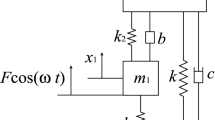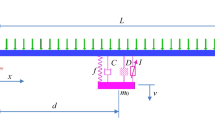Abstract
Purpose
Inerter-based dynamic vibration absorber (IDVA) has been widely used to reduce the responses of vibration systems. Its application to the nonlinear system is underexamined and will be explored.
Methods
In the present investigation, an IDVA is applied to a randomly excited nonlinear system which is of concern. The random response of the nonlinear system is analyzed by introducing a generalized harmonic transformation and establishing the relationships between the responses of the nonlinear main system and the IDVA secondary system.
Results
Numerical results are given to illustrate the applicability and effectiveness of the proposed method. The influences of the parameters of the IDVA, the main nonlinear system, and the excitation on the mean-square displacement response of the nonlinear system are investigated. Furthermore, the suppression effectiveness of the IDVA is discussed in detail.
Conclusion
Comparison of the approximate analytical results and simulation results shows that the proposed method is accurate and effective in quite large parameter ranges. Moreover, it is found that the response suppression effectiveness of the IDVA is robust to the main system nonlinearity and to the intensity of the random excitation.





Similar content being viewed by others
References
Smith MC (2002) Synthesis of mechanical networks: the inerter. Proc IEEE Conf Decis Control 2(10):1657–1662. https://doi.org/10.1109/cdc.2002.1184758
Schönfeld JC (1954) Analogy of hydraulic, mechanical, acoustic and electric systems. Appl Sci Res 3(1):417–450. https://doi.org/10.1007/BF02123920
Smith MC, Gb G (2005) Force-controlling mechanical device, Patent, Pub. No.: US 2005/0034943 A1
Wang FC, Hong MF, Lin TC (2011) Designing and testing a hydraulic inerter. Proc Inst Mech Eng Part C J Mech Eng Sci 225(1):66–72. https://doi.org/10.1243/09544062JMES2199
Li C, Liang M (2012) Characterization and modeling of a novel electro-hydraulic variable two-terminal mass device. Smart Mater Struct 21(2):025004. https://doi.org/10.1088/0964-1726/21/2/025004
Evangelou S, Limebeer DJN, Sharp RS, Smith MC (2006) Control of motorcycle steering instabilities: passive mechanical compensators incorporating inerters. IEEE Control Syst 26(5):78–88. https://doi.org/10.1109/MCS.2006.1700046
Chen MZQ, Papageorgiou C, Scheibe F, Wang FC, Smith MC (2009) The missing mechanical circuit element. IEEE Circ Syst Mag 9:10–26. https://doi.org/10.1109/MCAS.2008.931738
Hu Y, Chen MZQ (2015) Performance evaluation for inerter-based dynamic vibration absorbers. Int J Mech Sci 99:297–307. https://doi.org/10.1016/j.ijmecsci.2015.06.003
Hu Y, Chen MZQ, Shu Z, Huang L (2015) Analysis and optimisation for inerter-based isolators via fixed-point theory and algebraic solution. J Sound Vib 346(1):17–36. https://doi.org/10.1016/j.jsv.2015.02.041
Wang X, He T, Shen Y, Shan Y, Liu X (2019) Parameters optimization and performance evaluation for the novel inerter-based dynamic vibration absorbers with negative stiffness. J Sound Vib 463:114941. https://doi.org/10.1016/j.jsv.2019.114941
Smith MC, Wang FUC (2004) Performance benefits in passive vehicle suspensions employing inerters. Veh Syst Dyn 42(4):235–257. https://doi.org/10.1080/00423110412331289871
Hu Y, Chen MZQ, Shu Z (2014) Passive vehicle suspensions employing inerters with multiple performance requirements. J Sound Vib 333(8):2212–2225. https://doi.org/10.1016/j.jsv.2013.12.016
Hu Y, Chen MZQ, Shu Z (2017) Comfort-oriented vehicle suspension design with skyhook inerter configuration. J Sound Vib 405:34–47. https://doi.org/10.1016/j.jsv.2017.05.036
Lazar IF, Neild SA, Wagg DJ (2014) Using an inerter-based device for structural vibration suppression. Earthq Eng Struct Dyn 43(8):1129–1147. https://doi.org/10.1002/eqe.2390
Marian L, Giaralis A (2014) Optimal design of a novel tuned mass-damper-inerter (TMDI) passive vibration control configuration for stochastically support-excited structural systems. Probabilistic Eng Mech 38:156–164. https://doi.org/10.1016/j.probengmech.2014.03.007
Petrini F, Giaralis A, Wang Z (2020) Optimal tuned mass-damper-inerter (TMDI) design in wind-excited tall buildings for occupants’ comfort serviceability performance and energy harvesting. Eng Struct 204:109904. https://doi.org/10.1016/j.engstruct.2019.109904
De DD, Ricciardi G (2018) An enhanced base isolation system equipped with optimal tuned mass damper inerter (TMDI). Earthq Eng Struct Dyn 47(5):1169–1192. https://doi.org/10.1002/eqe.3011
De AM, Giaralis A, Petrini F, Pietrosanti D (2019) Optimal tuning and assessment of inertial dampers with grounded inerter for vibration control of seismically excited base-isolated systems. Eng Struct 196:109250. https://doi.org/10.1016/j.engstruct.2019.05.091
Masnata C, Di MA, Adam C, Pirrotta A (2020) Smart structures through nontraditional design of tuned mass damper inerter for higher control of base isolated systems. Mech Res Commun 105:103513. https://doi.org/10.1016/j.mechrescom.2020.103513
Javidialesaadi A, Wierschem NE (2018) Three-element vibration absorber-inerter for passive control of single-degree-of freedom structures. J Vib Acoust Trans ASME 140(6):061007. https://doi.org/10.1115/1.4040045
Alotta G, Failla G (2020) Improved inerter-based vibration absorbers. Int J Mech Sci. https://doi.org/10.1016/j.ijmecsci.2020.106087
Shi X, Zhu S (2018) Dynamic characteristics of stay cables with inerter dampers. J Sound Vib 423:287–305. https://doi.org/10.1016/j.jsv.2018.02.042
Jin X, Chen MZQ, Huang Z (2016) Minimization of the beam response using inerter-based passive vibration control configurations. Int J Mech Sci 119:80–87. https://doi.org/10.1016/j.ijmecsci.2016.10.007
Jin X, Chen MZQ, Huang Z (2019) Suppressing random response of a regular structure by an inerter-based dynamic vibration absorber. J Vib Acoust Trans ASME 141(4):1–10. https://doi.org/10.1115/1.4042934
Gonzalez-Buelga A, Lazar IF, Jiang JZ, Neild SA, Inman DJ (2017) Assessing the effect of nonlinearities on the performance of a tuned inerter damper. Struct Control Heal Monit 24(3):1–17. https://doi.org/10.1002/stc.1879
De DD, Ricciardi G (2018) Optimal design and seismic performance of tuned-mass-damper-inerter (TMDI) for structures with nonlinear base isolation systems. Earthq Eng Struct Dyn 47(12):2539–2560. https://doi.org/10.1002/eqe.3098
Lei XF, Wu CJ (2018) Investigating the optimal damping performance of a composite dynamic vibration absorber with particle damping. J Vib Eng Technol 6(6):503–511. https://doi.org/10.1007/s42417-018-0067-7
Faal RT, Crawford B, Sourki R, Milani AS (2021) Experimental, numerical and analytical investigation of the torsional vibration suppression of a shaft with multiple optimal undamped absorbers. J Vib Eng Technol. https://doi.org/10.1007/s42417-021-00295-w
Cai GQ, Lin YK (2001) Effect of secondary systems on response of nonlinear primary system to random excitation. In: Corotis RB, Schueller GI, Shinozuka M (eds) Proceedungs of 8th international conference on structral safety and reliability ICOSSAR'01. Swets & Zetitinger, California
Luan XL, Wang Y, Jin XL, Huang ZL (2019) Response evaluation and optimal control for stochastically excited vibro-impact system with Hertzdamp contact. J Vib Eng Technol 7(1):83–90. https://doi.org/10.1007/s42417-019-00080-w
Acknowledgements
This study was supported by the National Natural Science Foundation of China under Grant Nos. 11672262, 11972317, and 11532011.
Author information
Authors and Affiliations
Corresponding author
Ethics declarations
Conflicts of interest
The authors declare that they have no conflict of interest.
Additional information
Publisher's Note
Springer Nature remains neutral with regard to jurisdictional claims in published maps and institutional affiliations.
Rights and permissions
About this article
Cite this article
Chang, W., Jin, X., Huang, Z. et al. Random Response of Nonlinear System with Inerter-based Dynamic Vibration Absorber. J. Vib. Eng. Technol. 9, 1903–1909 (2021). https://doi.org/10.1007/s42417-021-00334-6
Received:
Revised:
Accepted:
Published:
Issue Date:
DOI: https://doi.org/10.1007/s42417-021-00334-6




